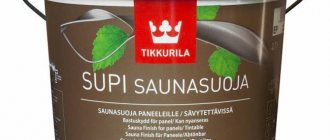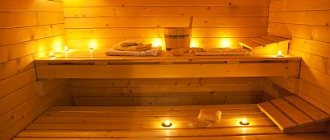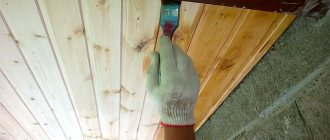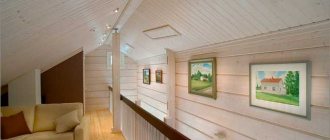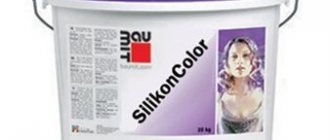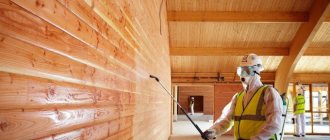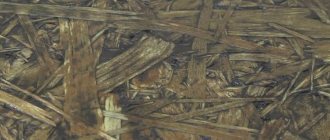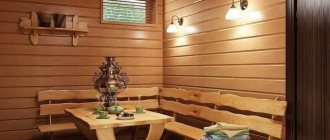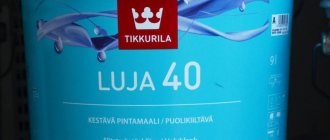Briefly about the main thing
To process lining in a bathhouse, materials that are resistant to temperature changes, humidity, and washing are used.
Also important is inertness to fungus, mold, bacteria, and a safe composition for humans. When heated, many materials release toxins and other harmful substances, so the use of antiseptics, fire retardants, drying oils, varnishes with solvents and acrylic resins is unacceptable for the steam room.
For walls and ceilings, impregnations, mastics, oils and some varnishes are used. For shelves only oil or wax based formulations. This prevents the formation of a thick film to avoid burns.
Bleach is used in any room of the bathhouse, but before further processing of the wood, it is necessary to wait until the chlorine evaporates and the hydrogen peroxide decomposes.
Antiseptics and fire retardants are classified as pre-treatment agents for wood, but are not used as independent coatings. They protect the lining and help reduce the consumption of the finishing coating.
Criterias of choice
Heat-resistant paints for rooms with high temperatures
For each room in the bath complex you need to choose your own treatment option.
- Acrylic or oil paints are not suitable for steam rooms, although acrylic heat-resistant compounds can be used. Oil is good because it impregnates the top layer of wood and prevents it from drying out. A polyurethane-based varnish is suitable.
- In a sauna, the main factor of choice is heat resistance. Special water-soluble paints, oil waxes, and waxes are suitable. Oils and oil paints cannot be used.
- For the washing room, paints and varnishes are purchased that are as resistant to water as possible - latex or polyurethane based. Oil is not suitable: the product does not form a waterproof film, but only prevents moisture from penetrating deep into the wood.
- For the dressing room, the only selection criterion is the safety and beauty of the finish. It is undesirable to use compositions based on drying oil: they take a long time to dry and retain an unpleasant odor.
The coloring agent should not contain formaldehyde. At high temperatures, the substance is destroyed and released into the air.
Types of coatings
The wood in the bathhouse is coated with paint to reduce exposure to moisture and high temperature.
The steam room and washing room are subject to the greatest load. However, this load is different.
- In a sauna, the air temperature can rise to 110°C. However, the humidity here is low. Paint for such a room must withstand heat, but may be sensitive to water.
- In the steam room, the humidity is much higher - from 70 to 100%, depending on the type of bath. The temperature is noticeably lower – it rarely rises above 60°C. The finishing material must be resistant to both water and steam and temperature changes.
- In the washing room, the temperature is not higher than a comfortable +30°C, but the humidity here can be high - 90–100%. The paint chosen is as waterproof as possible.
In practice, painting the inside of a bathhouse, especially a log house, is not a good idea. Any paint will be less resistant to the above factors than the wood itself. But if there is no other way to protect the finish, they also resort to painting.
Oil impregnations and varnishes
Effect of oil impregnation against moisture
A bathhouse is a structure used with a certain frequency. The high temperature in the steam room is maintained only during the procedure. Then the room is specially ventilated, cooling to a low temperature.
In this mode, the boards are more likely to dry out and become covered with cracks rather than mold and rot. Therefore, oil impregnations and varnishes are best suited for treating the steam room.
The oil penetrates the top layer of the wood, forming not a film, but a structure impenetrable to water. At the same time, the wood continues to expand normally and decrease in volume as the temperature changes. This way the oil prevents cracks from appearing.
Antiseptics for bath floors
The floor in the bathhouse is covered with antiseptic impregnations against rotting.
It is not enough to paint the steam room or sauna in the bathhouse - you need to take care of protection from rotting. The weak link in this room is the floor. Water flows onto it, steam is deposited, and it comes into contact with a cold concrete base or soil. To prevent the wooden floor in the bathhouse from rotting 5-6 years after construction, it must be treated with antiseptic impregnations.
Liquids based on substances that have a disinfecting effect:
- Acrylic-based water-based compositions. Moisture-resistant, prevent the growth of fungus, but are not very effective. More suitable for processing the dressing room.
- Organic – based on oils. They are better absorbed by wood and are moisture resistant.
- Products based on wax and urethane oils are absorbed to great depth. In addition to the water- and dirt-repellent effect, they give the timber and lining velvety and softness.
- Combined compositions increase both water resistance and fire safety.
It is strictly forbidden to use compounds that release toxins when drying to treat wood.
Water-dispersed impregnations
Acrylic paints reduce the harmful effects of moisture on wood
You can paint the logs inside the sauna or steam room with water-soluble paints.
The floor and walls in the steam room are painted with water-dispersed acrylic paint. It is quite resistant to temperature changes and does not prevent the penetration of steam. The hiding power is usually low, but the wood can be given any color. The downside is its low durability, the paint washes out quite quickly.
Paint for a bathhouse in a washroom should be as resistant to water as possible. The best products are latex or polyurethane based. For a dressing room or rest room finished with plaster, you can use any compositions marked “for interior decoration.”
The paint forms a film coating on the surface of the wood. And oil compounds penetrate inside, so in the steam room the walls are treated with impregnations.
Wax-based impregnations
Wax paint does not allow moisture to pass through, so it is well suited for baths and saunas
Wax is offered in liquid - viscous composition, and solid. The latter is somewhat more difficult to apply without the habit, but the treatment is carried out less frequently. The product does not create a sticky film and does not attract dirt.
If you only need to protect surfaces from water and steam, wax is more suitable. It is transparent, does not hide the structure of the wood, has some antioxidant activity, and therefore prevents the darkening of the wood.
Water-based polyurethane varnish
This is a kind of resin solution, where water, ethanol, and ether are used as a solvent. For the bath, choose water-soluble varnishes. They are resistant to high temperatures and to acids, oils and salts.
Polyurethane varnish is wear-resistant. Since it is based on water, the varnish layer does not create increased tension on the surface of the wood, and therefore is not prone to cracking. And since the resins polymerize already during drying, there is no subsequent peeling.
Types of premises
Fortunately, there are not many rooms in the bathhouse (in a standard one). Therefore, we will quickly go through the options of what paint to paint the inside of the bathhouse.
Steam room
This is the most problematic room. Many people believe that there is no need to paint anything there at all, but the price for such a decision is rapid darkening of the wood (and almost everyone has a steam room traditionally made of wood or lined with wood), cracking of the wood (this happens more often from poor ventilation during drying), susceptibility to rotting and mold damage (linden and aspen are very unstable species).
So the absence of any protective coatings, on the one hand, should be considered environmentally friendly, and on the other, costly in terms of future repairs.
You can paint the inside of the steam room with both paints and varnishes, but let them be water-soluble paints. And it would be nice if the label mentioning GOST standards stated that this composition is applicable in the steam room.
Washing
Both silicone and acrylic paints are suitable here. In general, everything that patiently endures the effects of moisture.
Other paints will crack and peel off in pieces under constant exposure to water.
ADVICE! Water dispersions do not tolerate frost well: if the water in the paint freezes, then after defrosting it will lose its quality. Therefore, buy them in the warm season, produced recently.
Impregnations and varnishes are also suitable for painting washing areas.
Again we draw your attention to scuba gear
Of course, in the second case, it is better to paint when it is possible to ensure the best ventilation and the absence of people. Don't forget to use respiratory protection.
IMPORTANT! Remember that enamels and alkyd paints are fire hazards, but water-soluble paints are not.
Is it possible to paint the inside of a bathhouse?
Most people believe that painting the inside of the bathhouse is not necessary. However, over time, the wood begins to darken and crack, which occurs with constant exposure to high temperatures and in the absence of a proper ventilation system. The tree is then damaged by mold and other pathogens, which ultimately leads to rot.
If you do not treat surfaces with impregnations, varnishes and paints, you can get a completely environmentally friendly structure. On the other hand, you should stock up on money and time for future repairs. It is important to understand that when heated, almost any paintwork material releases particles of its chemical compounds into the atmosphere. But there are paints that are acceptable for use in steam rooms.
There are paints that are acceptable for use in steam rooms.
Requirements for decorative coating
When choosing paint for decorating the interior of a bathhouse, you should take into account that this material must meet the following requirements:
- protect the wood surface from the effects of aggressive environments that occur in the steam room and dressing room;
- withstand exposure to high air temperatures;
- maintain the integrity of wood and extend its service life;
- provide treated surfaces with an attractive appearance.
Remember that the time during which you can use the bathhouse without major repairs depends on what you paint the inside of the bathhouse with.
In addition, the following factors must be taken into account:
- the type of wood used;
- the ability to perform additional coloring;
- surface condition before treatment.
Special materials should be used for surface treatment
For those craftsmen who have not yet decided how to paint the inside of the bathhouse, it should be noted that most often special varnishes with special properties are used for this purpose:
- High coefficient of vapor permeability. This allows you to avoid the appearance of mold, prevents the appearance of fungi and bacteria, and prevents the formation of condensation.
- The ability to apply a new layer without cleaning the surface from the previous one.
- The presence of pigments that emphasize and highlight the natural texture of the wood with which the steam room and dressing room are decorated.
If you are not satisfied with varnish, acrylic bath paint is an alternative: you can use water-based mixtures inside. Considering the resistance of acrylates to low temperatures, this same type of decorative finish can also be used for facade work (the instructions for use confirm this).
Photo of a steam room whose walls are varnished
The advantages of paint over varnish include a large range of colors and a long service life of the decorative coating.
Application
Since users often have private questions about the applicability of certain dyes in a bathhouse, we will try to clarify these points without waiting for questions in the comments.
Can the floors be painted?
Can. Moreover, if we are not talking about a steam room or a washing room, you are generally not limited in your choice. But even the steam room and washing room are no exception - if you use specialized dyes or impregnations.
The floor in the steam room is the zone of least heating , and this applies even more to the sauna, because there the air flow is usually through the bottom of the entrance door, and cold air spreads along the floor, cooling it. In a Russian bath, everything is sealed to the maximum, but there and in the working area the temperature is low, so the floors have a low temperature in both cases.
We have already written about whether it is possible to paint the floors in a bathhouse with paint. However, we consider it possible to repeat that all options come down to oil impregnations (the Finns are not afraid that it will be slippery), as well as acrylate compounds (see Tikkurila products above).
In fact, if you want to paint the floor in the steam room and washing room, use the most environmentally friendly compounds - those that dissolve in water . For example, acrylic bath paints mentioned above.
Walls
There shouldn’t be any problems with this at all, because for the floor you still need to somehow select a composition with the greatest wear resistance, and for walls any composition is suitable - paints, varnishes, impregnations, any composition (preferably harmless).
You can read an overview of the options in this article.
How to paint stoves, boilers, tanks?
In general, it is correct that all equipment associated with heating water needs protection from corrosion, and certain paints and varnishes can help with this. You just need to figure out what exactly is suitable for these purposes.
For a metal stove
The temperature in the stove depends on the combustion temperature of the wood. Firewood comes in different types of wood and different humidity levels. Plus, another important point is air access: the more air there is, the higher the flame temperature.
Let’s assume that the combustion temperature, which varies somewhere from 500 to 1000 degrees “ideally” (that is, dry ash firewood, for example, with sufficient oxygen), in reality is 600-800 degrees (if you don’t burn it with poplar) . In this case, you should focus on paint with heat resistance of 650 degrees.
the CERTA already mentioned above, there are other companies that produce silicone enamels. However, few people have high temperature limits. For example, Sniezka can withstand up to 500 degrees. In general, it is worth understanding that on this site we do not promote the products of certain companies, we are more interested in the quality characteristics of the products.
In general, either measure the temperature of the furnace with a thermometer, or somehow be guided by the color of the metal's heat (there are tables where the shade of red is converted into degrees, but, of course, it is difficult to determine the shade by eye).
In addition, there is a useful video that tells you exactly what kind of paint and how much paint you will need in your work:
For boiler
The choice of paint for your sauna boiler depends on what type of fuel you use to heat it. Coal burns at a higher temperature than wood. Ideally - at 2000 degrees, in reality - at 1000. Therefore, the boiler should be painted with paint that can withstand up to 1000 degrees.
For hot water tank
The hot water tank does not heat up above the boiling point of water. Therefore, the paint for a hot water tank in a bathhouse can be exactly the same as that used for painting radiators . Although, if there is anything left from painting the stove, you can use that too.
Choosing paints for concrete floors
There are four types of paints used to paint concrete floors: acrylic, epoxy, acrylic-silicone and alkyd-urethane.
Acrylic
Such paints are resistant to water and temperature. Paint for concrete floors makes the surface matte, semi-matte and glossy.
To dissolve acrylic paints, use plain water and acrylic thinners. The painted surface is ready for use after 48 hours.
This type of floor paint should not be used on concrete floors that have previously been painted with epoxy or polyurethane products.
Epoxy
Two-component paint compositions are mixed with a construction mixer before starting the painting process.
Before using paints, the floor is treated with a primer - an epoxy compound diluted 25% with ordinary water.
Complete drying is achieved after 7 days, but the surface can be used within 24 hours. Concrete floor paint has a limited range of colors.
Alkyd-urethane
The materials are distinguished by a high degree of concealment and require painting the floor in several layers. Concrete paint is resistant to rapid abrasion and temperature conditions. White alcohol (15%) is used for dilution.
The paints are distinguished by a wide palette of colors and an attractive gloss of the painted surface.
Preparing the base
Before pouring concrete on the bathhouse floor, it is necessary to properly prepare the base. Otherwise, the floor will have low strength and reliability characteristics, will last much less and is unlikely to provide adequate comfort.
Alignment
Before starting work, remove a layer of soil from the base along with any remaining organic matter. Usually 40-50 centimeters is enough. Then the surface is leveled, making sure to make a pit in the center of the room where the water from the bathhouse will go.
Drainage from the pit is carried out beyond the foundation and is realized through a drainage pipe with a cross-section of 10-20 centimeters dug in the corner under a slope. Thanks to this design, it will be possible to ensure maximum comfort in the operation of the bath and avoid the accumulation of large volumes of water.
Seal
Both layers must be thoroughly compacted. They will protect the concrete floor in the bathhouse from rising moisture from the soil and other troubles.
Before building a bathhouse and making a concrete floor in it with your own hands, you should prepare the necessary tools and materials:
- gravel;
- Styrofoam;
- roofing felt;
- slag;
- cement;
- mineral wool;
- sand;
- expanded polystyrene;
- reinforcing mesh;
- roulette;
- self-tapping screws;
- screwdriver;
- drill;
- putty knife;
- roller;
- building level.
Features of choosing a coloring composition for a bath
The difficulty of choosing is due to temperature and humidity. The heat is much stronger in the room closer to the ceiling, and with strong heating, as mentioned earlier, coloring pigments release toxic substances into the air.
Therefore, in a steam room, it is advisable to treat the ceiling and upper part of the room with impregnations. Like paints, they differ in their composition and release form; they can be water- or oil-based.
Before purchasing, it is important to determine the area where it will be used (ceiling, floor, walls, etc.). The choice is also influenced by subsequent processing, namely, whether the surface will subsequently be covered with a decorative layer or not. The next factor is ease of application, as well as the degree of moisture protection. The optimal product is considered to have good moisture-proof and steam permeability properties.
In the steam room, it is advisable to treat the ceiling and upper part of the room with impregnations.
Selection of paint and varnish materials for interior work
Requirements for coating materials vary depending on the processing area. The steam room is considered the most problematic place. Oil-based coatings better penetrate deep into the natural structure of the material, prolonging its service life, but at the same time they are characterized by increased toxicity and an unpleasant odor due to the presence of solvents in their composition. They are ideal for treating the outside of walls, as well as the dressing room.
Water-soluble impregnations are suitable for this area. They are based on acrylic, and an additional component is color, which gives the surface a particular shade. This impregnation can be used to treat the structure both inside and outside. However, despite all the advantages, acrylic compositions have a significant disadvantage - over time they are washed out of the wood structure.
In order for the surface to retain its properties for as long as possible, it is necessary to paint it periodically. Another option is to apply a waterproofing compound first and only then impregnation.
How else can you paint a bathhouse inside a steam room? Instead of drying oil, you can use paraffin oil or any other composition intended directly for the steam room. This oil is distinguished by its safety for health while maintaining characteristics similar to drying oil.
In the bathhouse, surfaces are treated with impregnation several times a year.
In order for the surface to retain its properties for as long as possible, it is necessary to paint it periodically.
The least heating zone in the steam room is the floors. Therefore, the answer to the question of how to paint the floors in a steam room in a bathhouse is quite simple - any oil impregnations or acrylate compounds. For wooden floors, you can use water-based varnishes, which do not have an unpleasant odor and are much easier to apply. When choosing a water-based varnish, it is better to give preference to European manufacturers, since the quality of these particular products is much higher.
You can often find concrete flooring. This coating must be painted. Epoxy, polyurethane and acrylic mixtures are suitable for this.
For wooden floors, you can use water-based varnishes, which do not have an unpleasant odor and are much easier to apply.
Popular formulations
Finnish "Tikkurila"
Tikkurila is a well-known company not only in its homeland, whose products are often chosen by Russian residents. With all the wealth of choice of its other products, Tikkuril sauna and bath impregnations are quite few in number, and it would not be difficult to list them:
- Supi Laudesuoja is the same paraffin oil mentioned above. It is intended to cover only the shelves with them.
- Supi Saunavaha - the composition is not fully indicated, but the manufacturer says that it contains natural wax. Can be used not only for shelves, but also for walls, ceilings, doors and window frames.
Sauna impregnation Tikkurila Supi Saunavaha for baths and saunas, colorless 0.9 l. Photo Petrovich
There are also a couple of acrylate compounds - these are water-based varnishes, which already contain antiseptics, although only against mold and blue stains. The names are: Supi Arctic and Supi Saunasuoja. Both are suitable for walls and ceilings and should not be used for floors.
ATTENTION! Finnish impregnations for baths and saunas do not differ in variety at all. If you look at Teknos products, it turns out that they are the same, only the serial name Supi must be replaced with Satu.
"Neomid"
is also familiar to many thanks to its advertising. She has a variety of antiseptics that are suitable for internal and external work, as well as for protecting wood used in particularly difficult conditions (we are talking about contact with water and soil).
But these are antiseptics that are suitable for use in residential and non-residential premises, not only in the bathhouse. Among the specialized products, there is such impregnation for baths as “Neomid 200” and “Oil for baths and saunas”.
"Neomid 200" is an antiseptic that can be used anywhere inside the bathhouse, including on the shelves.
Water antiseptic for baths and saunas Neomid 200 Proff 1 l. Photo by Leroy Merlin
“Oil for baths and saunas Neomid” is an impregnation for baths against moisture and rotting at the same time. Let us explain: usually they exist separately and are applied in different layers. First, the wood is impregnated with an antiseptic, and only water-soluble ones are used inside the bath, and then it is coated with oil or paint. Here it’s “two in one” – both oil and antiseptic. In any case, this is what we understood from the characteristics given on the manufacturer’s website.
There is also a wood bleach “Neomid 500” - it can also be called an impregnation. It is used when the surface of the wood has darkened or become stained with mushrooms. In this case, the treatment leads to an almost instantaneous change in color to the original one.
: "Aquatex" and "Eurotex"
Those who are hearing about these impregnations for the first time may want to watch the video we found. It describes their properties and scope of application:
GOL sauna
Many people know Palizh tinting materials and paints from the Udmurt company “New House”. She also has a GOL series, one of the directions of which is impregnation for baths and saunas GOL Sauna. There is everything you need for a bath - impregnation for the shelf, another impregnation for walls, ceilings, doors and windows, and a third for the floor.
The manufacturer claims that all formulations simultaneously protect against moisture and fungi. Impregnation for baths and saunas is an acrylic coating. The one intended for the floor is already an alkyd composition, that is, paint based on organic solvents. Well, the one for the shelves is some kind of secret product containing “natural wood softener.”
The readers have the same request - if anyone has used it, tell us about your impressions.
"Estate 409"
A very budget option for acrylic coating with an antiseptic included in it is impregnation for baths and saunas “Usadba 409”. That is, you don’t even need a primer - fungicides and insecticides are already included in the composition. In addition, it contains a tannin inhibitor, a substance that causes wood to darken over time.
In general, we can say that this is cheap acrylic paint or varnish (and cheapness here, by the way, is not at all an indicator of poor quality, rather an indicator of mass and therefore cheap production), to which everything possible has been added.
It's supposed to be usable everywhere except shelves and floors (that's what we think). Moreover, it is specially designed for wet rooms, therefore the steam room and washing room are the main candidates for painting with “Usadba 409”.
In our opinion, this is a very competitive option. The Finns also calmly add antiseptics to their acrylates. Another question: do their compositions match? But here you can trust the manufacturer’s certificates, if he has them and demonstrates them to the buyer.
As for color, the impregnation is colorless and there are no colors for it. Maybe it's for the better
Features of protection of different parts of the steam room
Of course, you can saturate the entire steam room and the furniture in it with one composition. And then coat it with one varnish. Moreover, the products currently produced are rarely limited to one protection function. They usually combine, for example, impermeability with antibacterial effects. But the conditions affecting different parts of the steam room are still somewhat different. Therefore, the processing requirements are also different.
Ceiling
Perhaps the least requirements are placed on this part of the steam room. It is exposed only to the temperature effects of steam. Water almost never reaches it. Therefore, it can simply be coated with a specialized bath varnish.
The ceiling in the bathhouse must be reliably protected from dampness and temperature Source eco-ceiling.ru
On our website you can find contacts of construction companies that offer bathhouse construction services. You can communicate directly with representatives by visiting the “Low-Rise Country” exhibition of houses.
Floor
Unlike the ceiling, all the water that is used in the steam room ends up on the floor. Therefore, the anti-water protection for floor boards must be very good. In addition to antibacterial and anti-water impregnation, it is advisable to cover the floor with a protective layer of varnish. But not every varnish is suitable for the floor. The protective layer should not be slippery. This is a must to protect the floor. Of course, the soles of your feet should not stick to the floor. Do not think that repeatedly coating the floor with varnish increases its safety. The thick layer of varnish cracks and water reaches the wood. In addition, the wood cannot “breathe” through such a coating and will still deteriorate.
When building a bathhouse, do not forget about impregnating the logs on which the floor boards are laid. This, of course, is not the inside of the bathhouse, and there are no special protection requirements for them. But if water gets to them, then sooner or later the floor inside the bathhouse itself will suffer, no matter how well it is protected.
Walls
Most of the impregnation for the bathhouse inside is spent on protecting the lining, which is usually used to line the walls. Therefore, you should not use impregnations and varnishes that, when heated, can release strong-smelling substances. And do not cover it with a protective layer that does not allow the wood to “breathe.”
Shelves and benches
The shelves are the main part of the entire steam room, for which it is, in fact, built. Lying on it should be comfortable, pleasant and safe for health. Wood is a poor heat conductor, so even at high temperatures you won’t get burned by it. It’s another matter if it is covered with a protective film, which can cause a burn if touched. Therefore, it is not recommended to use paints or varnishes for it. It is better to apply a special impregnation for the bath. Often such impregnations are wax-based.
The requirements for the safety and convenience of the surface of shelves and benches are so high that there are bathhouse lovers who believe that wood should be natural for them and not covered with anything at all. But this is still suitable for small bathhouses, where simple shelves can be replaced. And when real furniture masterpieces are built, it is better to find a high-quality composition and ensure their durability.
It’s not enough to create beauty – it also needs to be protected
Surface preparation and painting process
Whatever you paint the steam room in the bathhouse with, first the surface needs to be prepared, and taking into account the material (wood), this process is a necessity. First you need to prepare all the tools and the coloring composition itself. It is advisable to familiarize yourself with the recommendations of the masters. This is especially important to take into account for people who are encountering such work for the first time. Surface requirements:
- The surface shade should be uniform. The heterogeneous structure is degreased;
- Professionals treat the wood with hot drying oil, which helps stop the growth of bacteria;
- Using special equipment it is necessary to sand the surface.
The paint is applied with a roller, brush or spray gun. The last option is suitable for people who have experience working with such equipment. Otherwise, it is impossible to achieve the desired result.
Professionals treat the wood with hot drying oil, which helps stop the growth of bacteria.
Features of paint application
It is necessary to paint wood along the grain.
If paints are used to decorate baths and saunas, several recommendations are followed when working.
- Painting is most often done with a brush. No other tool is used for bath furniture.
- The paint is applied along the direction of the wood fiber. At least 2 layers are required. The second is applied only after the first has completely dried.
- At the ends, paint is applied in 4 layers.
It is much easier and faster to paint walls or ceilings using a spray gun.
Alternative coloring agents for baths
How to paint the walls inside a bathhouse if you don’t want to use toxic substances? Use folk recipes. In ancient times, people used natural substances in the form of oak bark decoction. It gives the wood a dark but natural shade. You can get a fire-fighting composition by mixing starch and ocher.
A combination of flax drying oil and beeswax in equal proportions is also known. To this day, people still use linseed oil and even vegetable oil as impregnation. However, time-tested, natural ingredients cannot withstand any competition with modern industrial drugs.
Oak bark gives the wood a dark but natural shade.
Regardless of the quality of the materials used, experts advise carrying out antiseptic measures by impregnating the wood at least once a year. It is important to follow all recommended actions. For example, despite the “perfect” composition of modern products, none of them will last long if applied to an unpolished surface. The main objective of the coating is not only to improve aesthetic results, but also to extend the operational life of the wood. Therefore, when purchasing ready-made preparations, you need to pay attention to highly specialized paints, impregnations and varnishes intended directly for baths and saunas.
Types of bath paints
There are requirements for materials for finishing baths and saunas, but they are not so severe. Bath paint for interior painting on wood can be:
- Enamel;
- Water soluble;
- Oily.
When applying enamel, a dense, glassy layer of coating is obtained. Alkyd compounds are used as a base, because their compounds are toxic. The decoration process is permissible if constant ventilation is possible.
When applying enamel, a dense, glassy layer of coating is obtained.
Oil paints are a mixture of coloring particles and oils that dry quickly. Initially, drying oil was used as a base, but modern products are quite diverse and now most people use artificial drying oil based on alkyd resin. Water-soluble compositions can have different bases, acrylic, latex, polyurethane, and so on.
Oil paints are a mixture of coloring particles and oils that dry quickly.
How and with what to treat lining in a steam room - practical tips
Building a bathhouse is a complex process that includes many different tasks. The basis of the bathhouse is a log house, which is additionally lined inside. The lining most often used is lining made from alder, aspen or spruce, which have high strength and resistance to steam and moisture.
However, the natural properties of wood are not always enough. In a bathhouse, wood is exposed to moisture and hot steam, which leads to deformation of the skin. To avoid damage to the wood, it is necessary to additionally treat its surface. In this article we will tell you how to treat the lining inside a bathhouse so as not to change it every year.
Installation of brick partitions in baths
If you were still in doubt up to this point, check out this list:
- The metal structure heats up very quickly, which does not allow the body to adapt to the high temperature.
- A metal stove cools down as quickly as it heats up. You have to constantly monitor the temperature by adding logs, which is not very economical.
- The material lined with brick will not heat and dry the air so quickly, which means the atmosphere in the steam room will be more comfortable.
- There is a high probability of being burned on the walls of a metal structure. People sitting next to the stove will not feel comfortable.
All these small shortcomings can be easily eliminated with the help of cladding, which will increase the performance of the stove, improve its design and neutralize harm to health, because people go to the bathhouse to improve their health, and not vice versa!
This is the most optimal solution in terms of efficiency and labor costs - to combine the advantages of a metal and stone stove.
At the moment, factories are producing stoves that are initially designed for further lining with brick; this design is the golden mean that will allow you to profitably equip an excellent steam room.
For lining the furnace you need to use only these types of bricks:
- red ceramic brick;
- fireclay brick.
Do not take sand-lime brick. It is great for cladding a house, but it is not suitable for lining a sauna stove. Lime-based bricks are simply not able to withstand constant temperature changes and high humidity in a steam room.
After just a few weeks of use, it will begin to deteriorate. And from a decorative point of view, it is not suitable and additional cladding will still be required.
Fireclay brick
Outwardly, it is, of course, inferior to red ceramic brick, but this issue can be resolved with decorative finishing cladding.
If there are no remaining bricks on the farm, it is better to buy a new one! Give preference to ceramic red brick. Its specific gravity is much lower than that of fireclay. It demonstrates excellent technical properties, reliability and durability. And externally, the stove, lined with red ceramic bricks, will delight you for many years with its stylish, authentic look.
The process of lining a sauna stove with bricks is not very complicated, and if you strictly follow the detailed instructions, even a beginner can handle it.
Brick lining scheme
Painting a brick oven
Preparatory stage: If there are minor defects (depressions, bumps, potholes), first plaster and level, and cover the seams with a clay solution. You can learn how to prepare a good clay solution from the corresponding article, which is on the blog...
Plaster is made from clay and crushed asbestos. The resulting mixture is carefully applied to a well-heated stove.
How to paint: The two most popular proven folk methods are lime or chalk. The third method is again heat-resistant paint, which is also used for iron sauna stoves.
Cooking and painting with chalk
Stages:
- Pour the pieces of chalk into a container (bucket, basin), fill with slightly warm water so as to cover the surface and leave for at least one hour;
- In another container, mix animal glue with warm water in a ratio of 25:1. Animal glues include gelatin, casein, albumin, and bone.
- Mix both solutions and bring to a homogeneous consistency. “To check the quality of the solution, drop it on a piece of glass or mirror placed vertically. If the density is normal, then the droplet will slide down by 2-3 cm.”
- Apply two or three layers. Each subsequent one, only after the previous one has dried. “For a more “clean” whiteness, you can add a tablespoon of blue to a bucket of the finished solution. It will remove some of the yellowness.”
Cooking and painting with lime
Steps:
- Solution proportions: 1 kg of lime / 1.5 liters of water at room temperature / 1 tbsp. spoon of drying oil / 25-30 grams of blue / 1 tbsp. spoon of salt. Mix. “The most durable whitewash is made from freshly slaked lime, and salt is added to make the lime coating less dirty.”
- Apply in two or three layers. Unlike whitewashing with chalk, each subsequent layer of lime whitewash is applied to the wet previous one. “If the stove in the bathhouse was previously painted with chalk, and you intend to use lime (and vice versa), the surface must be thoroughly cleaned of old paint.”
Proper processing of lining
Having decided how to cover the lining in the steam room of the bathhouse, you can proceed to the processing itself. To perform high-quality impregnation that will last a long time, we recommend that you read the following instructions:
- Processing lining in a steam room begins with preparing the wood itself. Clean it from various contaminants with sandpaper or other suitable method. It is also recommended to wash the boards with an aqueous solution of soda (300 g of soda per 10 liters of water);
- Next, you need to degrease the surfaces. Remember that not only the lining itself is impregnated, but also the frame to which it is attached;
- Sand surfaces with pumice to obtain a smooth finish;
- Next, you need to apply an antiseptic that will protect the wood from fungus and mold;
- Now you can saturate the paneling. When choosing impregnation for the dressing room, pay attention to the humidity of the air in it, as well as the temperature of the steam. If the indicators are approximately equal to the indicators inside the steam room, then it is necessary to use the same impregnation.
By doing all the work correctly, you can achieve an excellent result, as in the photo.
If you decide to paint wood, then you next need to decide how to paint the lining in the steam room of the bathhouse. Often, a special acrylic varnish is used for this, which can withstand high temperatures and does not release toxins, but special paint can also be used.
To paint the lining with high quality, you must follow certain rules:
- Painting of the lining is carried out in warm and dry weather.
- You can paint with a roller or brush, moving them parallel to the wood fibers so as not to leave streaks on the surface.
- Stir the paint thoroughly before applying to obtain a uniform color.
- Apply the paint in a thin layer - this will allow you to achieve the best coloring result.
Tools for work
A set of brushes for high-quality painting of wood in a bathhouse
To paint a dressing room or sauna inside a wooden bathhouse, you need the most common tools:
- brush – wide and narrow if there are a lot of carved parts on the furniture;
- roller – suitable for painting walls and floors;
- spray gun;
- a special swab for applying a wax coating;
- For this you can use an iron dishwashing sponge or a thick brush.
To prepare the surface you will need sandpaper, a sander, a vacuum cleaner to remove dust, etc.
Manufacturers
Bath paint is produced by domestic and foreign manufacturers. Its price depends on the material used and the quantity in the jar.
Belinka
The manufacturer's product range consists of paints, glazing compounds, varnishes, and impregnations. They have a wide range of colors, which allows you to bring any design idea to life. When using materials, the structure of the wood is preserved. Belinka produces polyacrylate paints that have water-repellent and vapor-permeable properties.
Tex
Paint from the Russian manufacturer Tex has protective qualities, which guarantees an increase in service life. The company produces soil and glaze antiseptics, drying oils, wax compositions, and fire-retardant impregnation. This allows you to choose an acceptable option for painting the bathhouse.
Saikos
The compositions of the German manufacturer are developed on the basis of natural oils and waxes. This ensures the preservation of the structure for many years.
Protecting wood before painting
Before applying paint, the log house must be protected from mold, mildew and insects, to reduce the risk of fire. For these purposes, many different means of both narrowly targeted and complex action are produced:
- antiseptics (designed to protect against mold and mildew);
- insecticides (to protect against insects);
- flame retardants (to protect against accidental fire).
